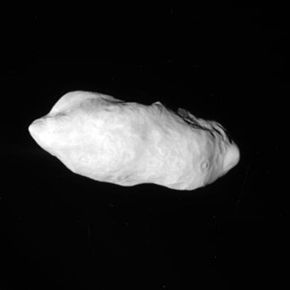 Prometheus image from Cassini (December 26, 2009) | |
| Discovery | |
|---|---|
| Discovered by | Stewart A. Collins D. Carlson Voyager 1 |
| Discovery date | October, 1980 |
| Designations | |
Designation | Saturn XVI |
| Pronunciation | /prəˈmiːθiːəs/[1] |
Named after | Προμηθεύς Promētheys |
| Adjectives | Promethean, -ian /prəˈmiːθiːən/[2] |
| Orbital characteristics [3] | |
| Epoch 31 December 2003 (JD 2453005.5) | |
| 139380±10 km | |
| Eccentricity | 0.0022 |
| 0.612990038 d | |
| Inclination | 0.008°±0.004° to Saturn's equator |
| Satellite of | Saturn |
| Group | Inner shepherd moon of the F Ring |
| Physical characteristics | |
| Dimensions | 137.0 × 81.0 × 56.2 km (± 1.0 × 2.8 × 0.8 km)[4]: 2 |
| 85.6±1.4 km[4]: 2 | |
| Volume | 327740±1710 km3[5]: 4 |
| Mass | (1.59720±0.00072)×1017 kg[a] |
Mean density | 0.4873±0.0026 g/cm3[5]: 4 |
| 0.0007–0.0056 m/s2[4]: 3 | |
| 0.018 km/s at longest axis to 0.028 km/s at poles | |
| synchronous | |
| zero | |
| Albedo | 0.6 |
| Temperature | ≈ 74 K |
Prometheus /prəˈmiːθiːəs/ is an inner satellite of Saturn. It was discovered on 24 October 1980 from images taken by the Voyager 1 probe, and was provisionally designated S/1980 S 27.[6]
In late 1985 it was officially named after Prometheus, a Titan in Greek mythology.[7] It is also designated Saturn XVI.[8]
Prometheus is extremely elongated, measuring approximately 137 km × 81 km × 56 km (85 mi × 50 mi × 35 mi). It has several ridges and valleys and a number of impact craters of about 20 km (12 mi) diameter are visible, but it is less cratered than nearby Pandora, Epimetheus, and Janus. From its very low density and relatively high albedo, it is likely that Prometheus is a very porous icy body. There is much uncertainty in these values, however, and so this remains to be confirmed.
- ^ "Prometheus". Lexico UK English Dictionary. Oxford University Press. Archived from the original on March 20, 2020.
- ^ "Promethean". Lexico UK English Dictionary UK English Dictionary. Oxford University Press. Archived from the original on March 20, 2020.
- ^ Spitale Jacobson et al. 2006.
- ^ a b c Thomas & Helfenstein 2020.
- ^ a b c Lainey et al. 2023.
- ^ IAUC 3532.
- ^ IAUC 4157.
- ^ USGS: Planet and Satellite Names and Discoverers.
Cite error: There are <ref group=lower-alpha> tags or {{efn}} templates on this page, but the references will not show without a {{reflist|group=lower-alpha}} template or {{notelist}} template (see the help page).